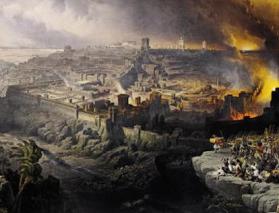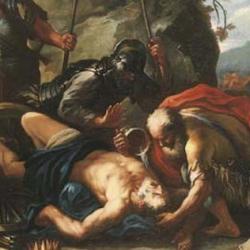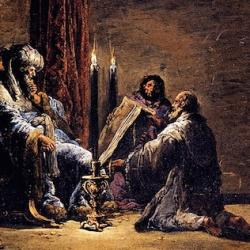Second Chronicles 8:11 (NASB) reads: “Then Solomon brought Pharaoh’s daughter up from the city of David to the house which he had built for her; for he said, ‘My wife shall not dwell in the house of David king of Israel because the places are holy where the ark of Yahweh has entered.’”
This comes in a passage emphasizing Solomon’s building projects (banah, “build,” appears eight times in chapter 8), and Solomon’s conformity to the statues of Moses (v. 13) and the ordinances of David (v. 14). William Johnstone notes that this is the only reference to Solomon’s marriages in Chronicles, and sees it as “testimony to the recognition which [Solomon] has secured even among the traditionally most threatening of Israel’s neighbors, and to the positive relations that can prevail when the nations are in harmony through that recognition” (1 & 2 Chronicles, 1.365). Mark Boda is surely correct that the notice about moving Pharaoh’s daughter illustrates that Solomon “is passionate for ritual purity” (1-2 Chronicles, 278).
But how does it show that? What regulations of purity and holiness is Solomon obeying?
Some have suggested that ethnicity is the issue: Pharaoh’s daughter is excluded because she is a foreigner. That’s not what the text says, however; Solomon says that “my wife” will no longer dwell in the house of David. Johnstone offers a more plausible explanation: “The problem posed by his wife is not her foreignness, but her marital status. At the heart of the issue lies the holiness of Jerusalem, and the degrees of holiness represented by the Temple, as the end of v. 11 makes clear. No wife of Solomon can reside in Jerusalem (cf. the sexual abstinence enjoined on Israel as part of the measures in preparation to encounter God in Exodus 19.14-15 or the legislation on purification from emission of semen or discharge of blood in Lev. 15.16-24). The maintenance of purity at the centre of his rule is an absolute prerequisite for the maintenance of the holiness that is Israel’s vocation” (1.366). John Mayer cites Peter Vermigli to similar effect: “women were unclean by their monthly periods. They were therefore unfit to be in the same house as the ark was” (Reformation Commentary on Scripture, Old Testament, 5.602).
But this surely proves too much, for it implies that no women were allowed to live in Jerusalem. As Shaye Cohen has argued, there is only slight evidence that menstruants were excluded from any environments (Number 5). Even if excluded, a woman can become clean after her period and return. Concerns about the occasional impurity of women cannot explain the permanent exclusion of Pharaoh’s daughter. Finally, men were as susceptible to impurity as women; involuntary ejaculation polluted a man.
This explanation is also hard to square with the apparent sequence of events. According to 1 Kings 3:1, Solomon brought Pharaoh’s daughter into the city of David, and this at the same time that the ark was there (1 Kings 3:15; cf. 2 Samuel 6:12-17; 1 Chronicles 15:1). Solomon seems to have built a house for Pharaoh’s daughter after he completed the temple (1 Kings 7:8; 2 Chronicles 8:1, 11), after the ark had been removed from the city of David into Jerusalem.
So: David brought the ark to the city of David; then Solomon set Pharaoh’s daughter in the city of David, while the ark was there; after the temple was finished, the ark was brought to the temple on Moriah (2 Chronicles 5:2-10); and only then was Pharaoh’s daughter removed from the city of David—the place where the ark wasn’t. Yet the reason for removal was “the places are holy where the ark of Yahweh has entered.” The difficulty is intensified by the fact that Pharaoh’s daughter is brought up (hiphil of ‘alah, “to cause to ascend”) from the city of David, and there is only one way “up” from the city of David—to the temple mount.
One might save Johnstone’s explanation in a couple of ways. Perhaps the ark’s years in the city of David left behind some residual sanctity; though the ark was no longer there, the place was still too holy for Pharaoh’s daughter to live. But this doesn’t explain why she was put there in the first place or why she’d follow the ark from the city of David to the upper city. Perhaps Solomon was correcting an error; Pharaoh’s daughter never should have been in the same location as the ark, as Solomon belatedly realizes. But that doesn’t explain why he brought her up.
Sara Japhet (I & II Chronicles, 626) neatly summarizes the problem: “If the queen’s living in proximity to the ark in the city of David constituted a transgression, why is this never mentioned in reference to Solomon’s initial decision to bring her ‘into the city of David until he had finished building his own house . . . (I Kings 3.1)?” Japhet agrees that Pharaoh’s daughter is excluded because she’s a woman, but sees this as a unique prohibition in Scripture.
A solution is perhaps available if we translate Solomon’s reasoning slightly more literally than the NASB: “. . . for [Solomon] said, ‘My wife shall not dwell in the house of David king of Israel, because they are holy where the ark of Yahweh has entered.” Instead of declaring the place holy, Solomon declares that certain people are holy (Heb, ki-qodesh hemmah), the ones to whom the ark of Yahweh “has entered to them” (‘asher-ba’ah ‘aleyhem). The rationale is perhaps that those who were dwelling in the city of David when the ark was there are too holy (not too impure) to continue dwelling in the city of David after the ark has been removed. Consecrated by proximity to the ark, they belong in a holier place, and so Pharaoh’s daughter is “brought up” to live in closer proximity to the temple.
Can we make sense of a notion of “contagious holiness”? According to Leviticus 7:27, anyone who touches most holy flesh or blood is consecrated, and needs to go through a ritual of “deconsecration” to get back to normal. Within Chronicles, the Levites who sang praise at the ark in the city of David are brought to the temple mount to continue their musical worship (2 Chronicles 5:11-14). Perhaps Pharaoh’s daughter has received an analogous consecration that permits her to “ascend” out of the house of David to the temple mount. This appears to fit with verses 7-8, where Solomon “raises” (‘alah) the descendants of the Canaanites to assist with his building projects. That isn’t presented as a subjection but as an elevation.
The typology of the passage is consistent with this interpretation. Yahweh descends in a cloud and fire to take up residence in the temple with His Bride, Israel. Solomon, Yahweh’s anointed, brings his bride into the city as well, so that the king-and-queen together provide an image of Yahweh and His people (as in the Song of Songs). Pharaoh’s daughter follows the progression of the ark, from the city of David into the higher temple-city. The deeper typology goes back to Eden: Having built the garden-temple and his own palace, Solomon brings his wife into the garden-city to be with him, because it is not good for a king to be alone. And, of course, the Edenic typology reaches ahead to portray a King who not only takes His throne, but goes to prepare a place on the throne for His church, the Queen of heaven.















